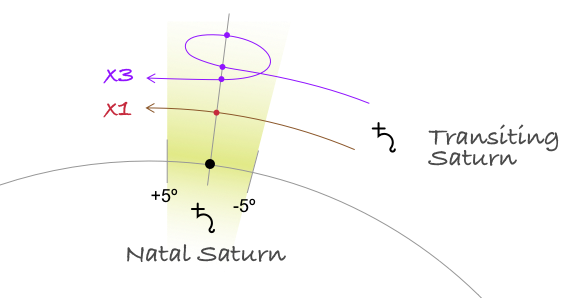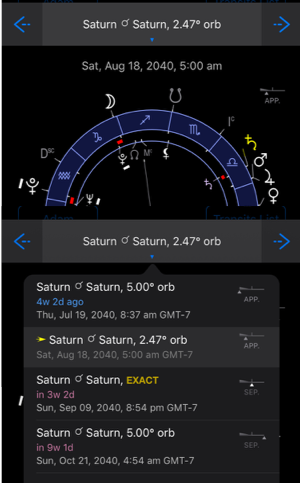The first Saturn return and the second Saturn return

Each Saturn return is a major milestone that marks the beginning of one of the Three Grand Chapters of human life. The ways of Saturn can be better understood by exploring its relationship to Time and the process of continuous growth and betterment.
The average lifespan of a human being is more or less equally divided into three large chapters:
- 0 to ~29 years old
- ~30 to ~60 years old
- the remainder of life that begins just before the 60th mark.
These broad Grand Chapters of human life are delineated by what is known as the Saturn return that defines the three distinct periods of:
- growth and maturation
- building and accomplishing
- retrospection and wisdom.
Each of these three descriptions represent a different aspect of Saturnian energy, and the three of them combined pass the sense of a spiral-like development of every human being that (provided you accept the model of reincarnation) follows the infinite progression:
… ➝ birth ➝ growth ➝ accomplishments ➝ wisdom ➝ birth ➝ …
This repeating spiralling cycle ensures that the human soul is busy attaining ever greater degrees of sophistication and accomplishment. It effectively guards against stagnation that naturally develops during the age of wisdom since the renewable energy of striving and learning belongs to the young.
And if we toss aside the model of reincarnations, Saturn returns still offer a useful way to perceive each human life in terms of succession of meaningful periods that may shed some light at the mysterious “meaning of life” question.
Saturn returns have a reputation of being challenging
The Saturn return is often seen as a challenging period time during which the person needs to reassess their past actions in the light of what’s possibly coming to them in the future. Some major changes may come out of that period and significant changes are never easy.
Yet certain misunderstandings make a Saturn return sound like an unavoidable trying and unpleasant event that just needs to be dealt with hunkered down with a “it shall pass” mantra.
One common mistake is to see the return as an independent one-off event to get through — which it isn’t. Each Saturn return is a recap of previous 29 or so years of life and an invitation to the next cycle of personal evolution.
What is a Saturn return
The Saturn return signifies a period of time when current position of Saturn crosses its Zodiacal position at the moment of birth as described by the natal chart.
Saturn crosses that mark on the ecliptic approximately each 29.5 years.
The crossing begins when Saturn is about 5º away (before) from the exact conjunction and develops until Saturn reaches about 5º separation from exact conjunction. For simplicity sake we use the average 5º as the “orb” for transiting Saturn. Each astrologer may have a slightly different orb preference, some prefer even tighter orbs.
Strength of a Saturn return
If we continue with the 5º orb example, then each Saturn return represents a period of time during which Saturn hovers around the point of exact conjunction. This period of time can display a significant variance:
- a relatively short ~12 weeks (3 months) transit
- an extra long ~50 weeks (nearly a year) transit
- a rather rare series of in-and-out of the orb periods.
The time window of Saturn return is defined by a possible retrograde movement of Saturn during that period. If Saturn goes retrograde during its return then:
- the return period will lengthen itself to nearly a year, and
- three exact conjunctions will take place instead of one.
The illustration below shows both scenarios.

The strength of a Saturn return is directly linked to its duration. Triple exact conjunction will consist of direct Saturn, retrograde Saturn and concluding direct Saturn passage over its natal (at-birth) position. Such direct–retrograde–direct pattern offers some extra time to reflect and adjust certain beliefs and attitudes during Saturn’s retrograde phase and prepare for the second direct exact conjunction of Saturn. It’s the year to always keep Saturnian values in mind and be aware that certain corrections and reconsiderations may be desired to achieve the most positive outcome.
A much shorter single pass Saturn transit of about 3 months culminates at the moment of its exact conjunction. Such transit is of a more dynamic nature and its outcome depends on how well the person has prepared themselves… years in advance.

Simply set the date to around 29th or 60th birthday when Saturn is roughly conjunct with its natal position.
Then long tap on Saturn transit item on the Transits list screen.
For more information read How to calculate astrological events — aspects, transits and retrogrades.
Saturn is about Time
Saturn is a Roman name of the ancient Greek god Kronos that rules over boundaries, structure and time. Modern words like chronometry, chronometer (time measurement) and chronic (as in disease) all come from the principle of Kronos.
An interesting side note: While Kronos establishes boundaries, Mercury (Greek Hermes) rules over the principle of crossing the boundaries.
To better understand Saturn returns one needs to learn appreciate the core actions of Saturn:
- making time measurable
- using time to form structures, giving shape to things, forming patterns
- introducing the principle of accountability for time spent.
Saturn performs a function of a “celestial accountant” through its nature of precise measurement and the ensuing sense of responsibility towards all kinds of resources that it cultivates in human minds.
“Don’t come unprepared”
Each Saturn return is akin to taking an exam. Firstly, one needs to make sure they’ve done their homework during the whole period of about 29 years leading up to the Saturn return. Secondly, one needs to form some ideas as to what they are heading towards in their life.
The outcome of a Saturn return isn’t really punishing. Saturn acts in an impartial manner reinforcing patterns that the individual has cultivated in the preceding time period.
Saturn moves through the houses
Movement of Saturn around the Zodiacal circle is akin to the movement of a watch hand. Using astrological houses makes more sense than using Zodiac signs: houses are more specific to each individual than more generic Zodiac signs.
Depending on what house system one uses, Saturn will spend varying amounts of time in each sector of the circle. Simpler house models that are based on equal divisions of houses and don’t use the midheaven point (for example, whole sign, equal house) take Saturn ~2.5 years to cross.
More sophisticated house models (for example, Placidus, Koch, Regiomontanus, Campanus) produce houses of varying size depending on geographic location and date of the natal chart. They are more complex but traditionally trusted to be more specific as they reflect more of celestial mechanics.
Approaching the First Saturn return at 27-31 years
The starting point is the house of Saturn’s natal position. It sets the “tone” for the next 29 years during which the person will travel through their time and will shape patterns that will be assessed during the first Saturn return.
Saturn’s natal position and especially its aspects with other planets provide important clues about early development and maturation processes that the young person is likely to go through.
The first chapter of life can also be subdivided into three parts — family, siblings and learning — each just under a decade long.
The first Saturn return is the person’s first encounter with the “celestial accountant” and for most young people it may be a confusing time period that will eventually project them into their 30s.
Generally Saturn favours persistence and structure, and those who spent time training themselves and developing the sense of responsibility and professional discipline are more likely to have an easier transition — they have done most of their work in preceding years — this approach strongly resonates with Saturnian values and principles.
And what about the others who may not have had an equal opportunity or were distracted by events out of their control? Saturn doesn’t punish, instead it gives the chance for new beginnings. The first Saturn return presents a clear opportunity for a reboot, and one needs to be aware of that and open to try things again, perhaps taking a slightly different angle. They may still well succeed since time doesn’t always move in a linear manner!
Towards the Second Saturn return at 56-60 years
The second “productive” period of life unfolds between approximately 30 and slightly under 60 years of age. As Saturn makes the second passage over the houses, the person goes through similar experiences yet transposed to a different octave.
Place of work replaces family, career replaces relationships with siblings and capital building is the former learnings “transposed” to some kind of financial denomination.
Creating one’s own family is a metaphor for a pattern giving birth to new patterns, similar to how fractals and crystals grow. The structure of creative multiplication unfolds in a Saturnian manner.
By the age of 56-60 years an individual usually forms a picture of what they have managed to achieve and what has eluded them. Nobody’s perfect and Saturn isn’t here to punish. Its function is to reveal structures and ensure ever repeating growth of life.
Aiming at the Third Saturn return… 84-90 years of age
The period before the third Saturn return unfolds between approximately 60 and 76 years (the current average life duration) or even longer depending how much life energy one’s body has been granted by mother Nature.
This period enjoys return to the roots, perhaps in the form of extended family, and often seeking inwards.
During that period Saturn is making its third and final traversing of the houses, beginning from the natal position. This gives a third precious opportunity to review what has been experienced and perhaps correct certain things for better.
In the advertising industry they say it takes three times for a viewer to see an advertisement before they can finally remember it. And that’s the essence of Saturn: rinse and repeat until core lessons learned and progress is made.
“The seven ages of man” – another way to slice life
A human life is made out of a number of cycles and arguably each planet introduces its own periodic influence. Astrology as a whole can be seen as a study of a circle!
One more interesting way to divide one’s life is described in an earlier story “The seven ages of man”. This is an experiential method that is based on the idea of the soul travelling through the planetary spheres in a linear matter.
So here we go, travelling in spiralling circles and along a line, both are wonderful metaphors of one’s life development.
Knowing Saturn is knowing Time
Saturn functions as a celestial rhythm setter that has always been associated with everything “chronological” – plans, obligations, commitments and ultimately dividends translated either into a monetary equivalent or a lasting bond of loyalty.
It does pay back to cultivate a sense of timing and long term obligations — the attitude naturally supported by Saturn. The fruit aren’t gathered instantly, instead they will reveal themselves over a longer period of time. Saturn return is one of those milestones along the life’s path that celebrate and support long term commitments that may take many forms: from enduring personal relationships to thorough studies and focused professional development.
6 Comments
Sven
Thanks for this easy to understand and well explained introduction to the cycles of Saturn. I can highly recommend this book, it helped me a lot to understand the sweet bitterness that might come around Saturnian Episodes.
Saturn: Spiritual Master, Spiritual Friend - Robert Wilkinson
Allison
Disappointed. I was hoping for some insight into what to expect with a second Saturn return. The article put a lot into a first return and barely touched on the second return , jumping right into third return. Odd with so many genx and boomers on this stage of life
lyn
Hi Alison, im 60, and saturn has now passed over his degree at birth, hes in his own sign of my bithchart, so showed up on my physical , body, Capricorn , being an earth , sign, caused a solid stream of dental , problems for 6 years, 25 capricorn, finally resulting in a 9 tooth bridge .I had always taken great care of my teeth, prior. After the bridgework was completed, with no further problems expected, 7 months went by, , then saturn retrograded, back onto the degree, And another trip to the dentist, revealed a small bone fragment , had been left inside the gum, under the bridge, and was causing agony for a few days, until it was removed. ! The bridgework was done just as covid began to go global, and everything was getting locked down. Thats my 2nd saturn return story, !!!
Dr.Phikthy
I am the goat. Jan 7 93…I am 29.5 yrs old. This has been the most awakening time ofmy life. And I will be famous. Dr.Philthy. Never give up. It’s never not gotten better yet and that’s a philthy fact.
Helmar
birth ➝ growth ➝ accomplishments ➝ wisdomheart ➝ clubs ➝ diamonds ➝ spadesOur life stages beautifully mapped via the 4 suits of the pack of cards. And within each suit we find 13 cards (Ace to King), marking the journey from wish to mastery, from the beginning to the next level of consciousness. And yes, Saturn and all his buddies also play a role, because they denote the creative process that starts with Mercury (mind) and goes through the stages until Neptune, which heals and dreams up new ideas, which in turn will be processed by Mercury again after one’s birthday.
So many systems, so much value, so much joy!
Time Nomad
The number four is the number of incarnation. It makes sense that many life related processes can be described in four stages. The symbolism is just there.